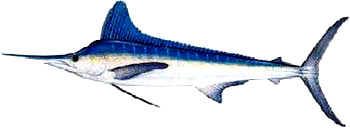
Kajikia albida
White marlin are the smaller of the billfish, reaching just over 9 feet and 180 pounds. They have a slender bill and their first dorsal fin is high but lobed rather than pointed like the similar blue marlins. They are dark blue on top and silver white with brown spots below, and their dorsal fins are dark blue with black spots. They are solitary fish that live in the open sea, hunting smaller schooling fish in nutrient-rich fronts.
Order – Perciformes
Family – Istiophoridae
Genus – Kajikia
Species – albida
Common Names
English language common names include white marlin, Atlantic white marlin, and skilligalee. Other names include aguja blanca (Spanish), agulha (Portuguese), bicuda (Portuguese), blanca (Spanish), cabezona (Spanish), espadarte-branco (Portuguese), espadon (French), marlin alb (Rumanian), and wit marlyn (Afrikaans).
Importance to Humans
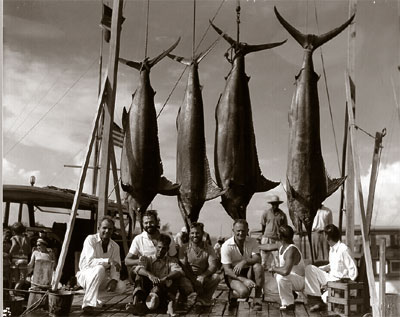
The white marlin is a popular game fish. The largest fishery for this species occurs in the summer, between Cape Cod, Massachusetts, and Cape Hatteras, North Carolina. It is marketed fresh everywhere it is caught, and sold frozen in Japan. It can be caught trolling at or close to the surface. Baits including mullet, mackerel, herring, and squid as well as lures can be successful in getting a white marlin to bite on a line. All billfish, including white marlin, must be handled carefully due to their ability to inflict serious wounds with their bill. Also, it is wise to wear protection on your hands when handling billfish due to the roughness of the bill. Otherwise, this fish is harmless to people.
Conservation
Currently a species of special concern, the National Marine Fisheries Service is petitioning to list the white marlin as threatened or endangered throughout its known range and to designate critical habitat under the Endangered Species Act (ESA).
> Check the status of the white marlin at the IUCN website.
The IUCN is a global union of states, governmental agencies, and non-governmental organizations in a partnership that assesses the conservation status of species.
Geographical Distribution
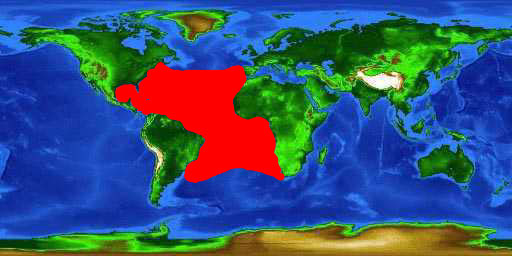
Occurring in the Atlantic Ocean, the white marlin has a distribution from approximately 45°N to 45°S in the western Atlantic Ocean and 35°S in the eastern Atlantic Ocean. As its distribution is limited by temperature, its boundaries vary throughout the year; it is found in the northern and southern extremes of its range only in the respective warm season. Specimens have been reported from the Mediterranean Sea and from the coast of France, but these are believed to be isolated occurrences of individuals who have strayed outside the regular distribution. While white marlin do travel long distances, they apparently do not perform the transoceanic migrations of related species.
Habitat
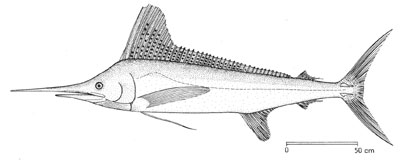
The white marlin is pelagic and oceanic, usually found in water over 325 feet (100 m) deep. It generally swims above the thermocline, in water of surface temperatures above 71°F (22°C), and salinities between 35-37 parts per thousand (ppt). White marlin often occur in oceanic currents that can flow between 0.5-2.3 mph (.8-3.7 kph). They are often associated with upwellings and weed lines, and frequent regions with benthic geographic features such as drop-offs, canyons, and shoals. White marlins do not tend to travel in schools, but are usually observed swimming alone or in pairs. While swimming they commonly display a technique known as “tailing,” in which only the dorsal lobe of the caudal fin is visible above the surface of the water. Small aggregations of white marlin may be observed around schools of bait fish. Limited schooling may occur, designated by sex or size during certain periods of the year, but little is known of this behavior.
Biology
Distinctive Features
This billfish has a long, compressed, moderately fusiform body. The upper jaw forms a bill, which is round in cross section, and long and slender in comparison to many other billfishes. Two dorsal fins and two anal fins are present. The first dorsal runs most the length of the body, with a large first lobe that tapers abruptly at approximately the 12th dorsal fin ray, and slowly thereafter. The maximum height of the large lobe is greater than the depth of the body. The second dorsal fin is inserted slightly posterior to the second anal fin. The first anal fin forms a strongly rounded lobe, while the second approximately mirrors the shape of the second dorsal fin above it. Pectoral fins are long and broad. Pelvic fins are inserted just below origin of pectoral fins, and are thin and equal or slightly shorter than pectoral fins. The caudal peduncle contains double keels. The body has a dense covering of bony scales. The lateral line is distinct, and runs straight along the body, with a single curve over the origin of the dorsal fin. The white marlin is very similar to the blue marlin (Makaira nigricans), and can be differentiated based on fin morphology. The white marlin has a rounded dorsal fin at the front end, a rounded tip on the pectoral and anal fins, and spots on the dorsal fin, while the blue marlin has pointed dorsal, pectoral, and anal fins and no spots on the dorsal fin.
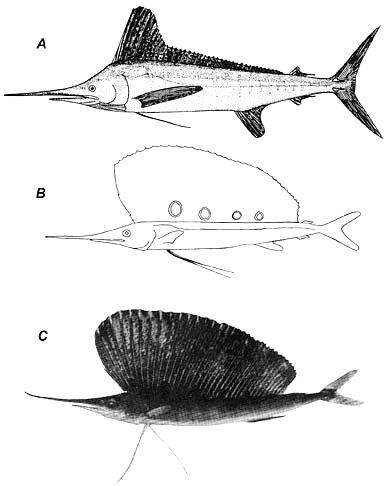
Coloration
The body is dark blue above and silvery white below, with brown spots on the sides of the white portion. In some specimens, many rows of blurred white lines may run the length of the body. The first dorsal fin is dark blue with many black spots, although these may fade towards the back of the fin. The second dorsal and pelvic fins are dark blue; the pectoral fins and caudal fin are blackish brown; the pectoral fins may be tipped in white. As with many istiophorids, color changes in response to level of excitement.
Size, Age, and Growth
The white marlin is smaller than many other billfishes. The maximum length for the white marlin is 110 in (280 cm) and maximum weight is approximately 180 lbs (82 kg). The fish taken by Atlantic longline vessels usually range from 51-83 in (130 to 210 cm) body length. The all tackle record, as recognized by the International Game Fish Association, is 181 lb 14 oz (82.50 kg). Females tend to live longer than males.
Food Habits
White marlin appear to be sight-oriented, daytime feeders. They often aggragate near fronts, the edges between water bodies of differing temperatures or salinities. These confluences produce nutrient-rich upwellings, drawing baitfish, and thus are successful feeding areas for the white marlin and other predatory fishes. There is some evidence that white marlin can stun or kill their prey by spearing or slashing it with their bill. Unlike swordfish, which use the same technique, the majority of prey items in the stomachs of white marlin appear without slashes. This indicates that white marlin more often overtake the prey by speed, rather than injuring it first. An important prey item for white marlin is squid. Bony fishes, especially dolphins, blue runner, mackerels, flying fish, and bonito are also commonly eaten. Round herring, which are abundant along the central Atlantic coast, are commonly consumed in that region. Much of the white marlin’s distribution coincides with that of the yellowfin tuna and the blue marlin. As these fishes feed on many of the same prey items, there may be considerable competition for food resources.
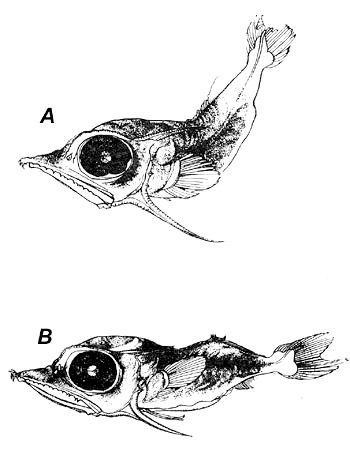
Reproduction
Spawning only once per year, white marlin migrate to subtropical waters and spawn in early summer, in deep oceanic waters. In the western North Atlantic, spawning grounds have been identified northeast of Little Bahama Bank, northwest of Grand Bahama Island, and southwest of Bemuda. They spawn in deep, blue oceanic water, generally with high surface temperatures ranging from 20-29°C. It is believed that they spawn in pairs, as opposed to communal or mass spawning.Little is known about the eggs and larvae of the white marlin, as they are difficult to identify. The larvae have large, prominent opercular spines and no bill. In juveniles, the dorsal fin rises abruptly at the third spine and gradually rising before sloping downwards at the eleventh spine. Juveniles have four ocelli along the lower portion of the dorsal fin, beginning between spines 14- 15, between 20-21, between 27-28, and between 32-33. With growth, the ocelli fade and through differential growth rates, the anterior portion of the dorsal fin grows comparatively much larger than the posterior portion, eventually forming the characteristic fin seen in adults.
Predators
Sharks are predators of marlin, including the white shark (Carcharodon carcharias) and shortfin mako (Isurus oxyrinchus). The cookie-cutter shark (Isistius brasiliensis) has also been known to take bites out of the flesh of marlins.
Parasites
The copepod Pennella filosa is reported to be a parasite of the white marlin. Tristomella laevis, a capsalid monogenean, is also a common parasite of both the blue and white marlin.
Taxonomy
The white marlin was first described by Poey in 1860 as Tetrapturus albidus. Junior synonyms include Tetrapturus lessonae Canestrini 1861 and Makaira lessonae Canestrini 1861. Other scientific names that have been used to refer to this fish are Lamontella albida Poey 1860 and Makaira albida Poey 1860.
Prepared by: Susie Gardieff